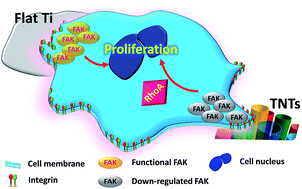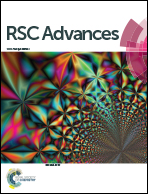Proliferation of preosteoblasts on TiO2 nanotubes is FAK/RhoA related†
Abstract
Topographies promote surface-dependent behaviors which may positively influence peri-implant bone healing. In this study the topological effects of TiO2 nanotubes (TNTs) on aspects of preosteoblast behavior was investigated. Specifically, we hypothesize that TNTs can influence the cell proliferation of preosteoblasts through cell adhesion and related modulation of FAK and RhoA. By culturing MC3T3-E1 cells on TNTs with different diameters (40 nm and 150 nm diameters), topography-dependent modulation in cell morphology and cell growth were observed. The average spreading area of the cell on flat Ti, 40 nm TNTs and 150 nm TNTs were respectively 2176.05 μm2, 1510.44 μm2 and 800.72 μm2. Proliferation increased among cells cultured on the 150 nm TNTs (28.6%) compared with on flat Ti (17.06%). The expression of FAK was 86.2% down regulated with the superimposition of the TNT topography. RhoA expression only slightly decreased (45.9%). Increasing the TNT diameter enhanced the initial adherent cell growth, which was relevant to the increased RhoA-to-FAK ratio in the cell. Increased TNT diameter was associated with a higher ratio and greater proliferation in the first 24 hours. These findings not only support our hypothesis, but suggest that RhoA might be critically involved in TNTs mediated cell proliferation. Future investigation using functional gain and loss of RhoA may further reveal its mechanism.


 Please wait while we load your content...
Please wait while we load your content...